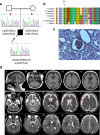Novel homozygous OSGEP gene pathogenic variants in two unrelated patients with Galloway-Mowat syndrome: case report and review of the literature
- PMID: 30975089
- PMCID: PMC6458604
- DOI: 10.1186/s12882-019-1317-y
Novel homozygous OSGEP gene pathogenic variants in two unrelated patients with Galloway-Mowat syndrome: case report and review of the literature
Abstract
Background: Galloway-Mowat syndrome (GAMOS) is a rare autosomal recessive disorder characterized by early-onset nephrotic syndrome and microcephaly with brain anomalies. WDR73 pathogenic variants were described as the first genetic cause of GAMOS and, very recently, four novel causative genes, OSGEP, LAGE3, TP53RK, and TPRKB, have been identified.
Case presentation: We present the clinical and genetic characteristics of two unrelated infants with clinical suspicion of GAMOS who were born from consanguineous parents. Both patients showed a similar clinical presentation, with early-onset nephrotic syndrome, microcephaly, brain atrophy, developmental delay, axial hypotonia, and early fatality. We identified two novel likely disease-causing variants in the OSGEP gene. These two cases, in conjunction with the findings of a literature review, indicate that OSGEP pathogenic variants are associated with an earlier onset of nephrotic syndrome and shorter life expectancy than WDR73 pathogenic variants.
Conclusions: Our findings expand the spectrum of pathogenic variants in the OSGEP gene and, taken in conjunction with the results of the literature review, suggest that the OSGEP gene should be considered the main known monogenic cause of GAMOS. Early genetic diagnosis of GAMOS is of paramount importance for genetic counseling and family planning.
Keywords: Case report; Galloway-Mowat syndrome; Genetic testing; KEOPS complex; Nephrotic syndrome; OSGEP.
Conflict of interest statement
Ethics approval and consent to participate
This study was approved by Fundació Puigvert Institutional Review Board. The parents of the patients provided written informed consent to participate in this study.
Consent for publication
The parents of the patients provided written informed consent to publish this case report, including case description, medical data, and images, maintaining anonymity.
Competing interests
RT is the Editorial Board Member of BMC Nephrology. The other authors declare that they have no competing interests.
Publisher’s Note
Springer Nature remains neutral with regard to jurisdictional claims in published maps and institutional affiliations.
Figures


Similar articles
-
A familial case of Galloway-Mowat syndrome due to a novel TP53RK mutation: a case report.BMC Med Genet. 2018 Jul 27;19(1):131. doi: 10.1186/s12881-018-0649-y. BMC Med Genet. 2018. PMID: 30053862 Free PMC article.
-
Galloway-Mowat syndrome in Taiwan: OSGEP mutation and unique clinical phenotype.Orphanet J Rare Dis. 2018 Dec 17;13(1):226. doi: 10.1186/s13023-018-0961-9. Orphanet J Rare Dis. 2018. PMID: 30558655 Free PMC article.
-
Nephrological and urological complications of homozygous c.974G>A (p.Arg325Gln) OSGEP mutations.Pediatr Nephrol. 2018 Nov;33(11):2201-2204. doi: 10.1007/s00467-018-4060-x. Epub 2018 Aug 23. Pediatr Nephrol. 2018. PMID: 30141175
-
Genetics and phenotypic heterogeneity of Galloway-Mowat syndrome.Cell Commun Signal. 2025 Jun 18;23(1):289. doi: 10.1186/s12964-025-02307-8. Cell Commun Signal. 2025. PMID: 40533795 Free PMC article. Review.
-
Extending the ophthalmological phenotype of Galloway-Mowat syndrome with distinct retinal dysfunction: a report and review of ocular findings.BMC Ophthalmol. 2018 Jun 22;18(1):147. doi: 10.1186/s12886-018-0820-4. BMC Ophthalmol. 2018. PMID: 29929488 Free PMC article. Review.
Cited by
-
Branching out in different directions: Emerging cellular functions for the Arp2/3 complex and WASP-family actin nucleation factors.Eur J Cell Biol. 2023 Jun;102(2):151301. doi: 10.1016/j.ejcb.2023.151301. Epub 2023 Mar 2. Eur J Cell Biol. 2023. PMID: 36907023 Free PMC article.
-
Whole-exome sequencing revealed a novel homozygous missense variant in OSGEP gene: a case report of Galloway-Mowat syndrome in Iran.CEN Case Rep. 2023 Nov;12(4):374-377. doi: 10.1007/s13730-023-00775-w. Epub 2023 Mar 1. CEN Case Rep. 2023. PMID: 36856752 Free PMC article.
-
O-sialoglycoprotein Endopeptidase (OSGEP) Suppresses Hepatic Ischemia-Reperfusion Injury-Induced Ferroptosis Through Modulating the MEK/ERK Signaling Pathway.Mol Biotechnol. 2025 Feb;67(2):689-704. doi: 10.1007/s12033-024-01084-y. Epub 2024 Mar 8. Mol Biotechnol. 2025. PMID: 38456959 Free PMC article.
-
Identification and characterisation of subtype-specific anti-N-CoR OSGEP protease in acute myeloid leukaemia (AML-M5) cell lineage.Biotechnol Lett. 2025 Aug 12;47(5):90. doi: 10.1007/s10529-025-03630-3. Biotechnol Lett. 2025. PMID: 40796998
-
Late Presentation of Galloway-Mowat Syndrome (GAMOS) Associated With Membranous Nephropathy: A Case Report.Cureus. 2025 Apr 11;17(4):e82108. doi: 10.7759/cureus.82108. eCollection 2025 Apr. Cureus. 2025. PMID: 40357071 Free PMC article.
References
Publication types
MeSH terms
Substances
Supplementary concepts
LinkOut - more resources
Full Text Sources
Medical

